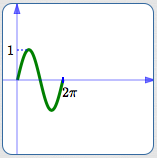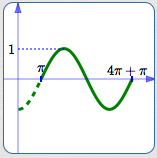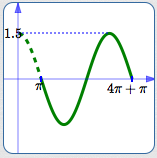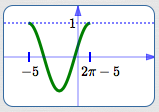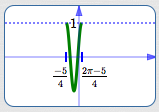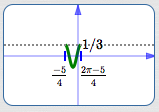 Graphing Generalized Sines and Cosines,
Like $\,y = a\sin k(x\pm b)\,$ and $\,y = a\cos (kx\pm B)\,$ (Part 1)
Graphing Generalized Sines and Cosines,
Like $\,y = a\sin k(x\pm b)\,$ and $\,y = a\cos (kx\pm B)\,$ (Part 1)
(This page is Part 1. Click here for Part 2.)
The prior section explored the (basic) graphs of $\,y = \sin x\,$ and $\,y = \cos x\,.$ However, these trigonometric functions frequently appear in ‘transformed’ versions.
You might see, for example: $$y = -1.5\sin \frac{1}{2}(x - \pi)$$ or $$y = \frac{1}{3}\cos (4x + 5)$$
The observations and techniques discussed in this section will allow you to reliably, quickly, and efficiently graph any function of the following forms, without memorizing a bunch of different formulas :
| $y = a\sin k(x\pm b)$ | $y = a\cos k(x\pm b)$ |
| $y = a\sin (kx\pm B)$ | $y = a\cos (kx\pm B)$ |
Notice, in particular, that the arguments $\,k(x\pm b)\,$ (first row) and $\,kx\pm B\,$ (second row) are different. For example, $\,2(x-5)\,$ is different from $\,2x - 5\,.$ These input types are commonly seen in applications.
In mathematics, the word ‘argument’ is often used to refer to the input of a function. For example, the argument of the sine function in the expression ‘$\,\sin k(x\pm b)\,$’ is $\,k(x\pm b)\,.$ As a second example, the argument of the cosine function in the expression ‘$\,\cos (kx\pm B)\,$’ is $\,kx\pm B\,.$
Any argument with only two types of terms—an $x$-term and a constant term—can be handled with the four-step graphing process discussed below. With this four-step technique, you don't need to identify which type of argument you're working with; you only need to identify the coefficient of the $x$-term.
For example, the four-step technique can be used to graph (say) $\,\displaystyle y = -9\sin\frac{\pi + 5x}{8}\,.$ Why? The argument has only an $x$ term and a constant term.
Here, $\,k = \frac 58\,.$ Why? Rewrite the argument (as needed) to see that the coefficient of $\,x\,$ is $\,\color{red}{\frac 58}\,$:
$$\cssId{s27}{\frac{\pi +\color{red}{5}x}{\color{red}{8}} = \frac{\pi}8 + \color{red}{\frac{5}{8}}x}\,$$The following two key observations will lead to an efficient approach. Click the Show/Hide buttons for additional information.
Observation #1
Each generalized function is the result of graphical transformation(s) chosen from:
Observation #2
The only transformation that changes the period is the horizontal stretch/shrink.
The horizontal stretch/shrink is caused by replacing every $\,x\,$ by $\,kx\,,$ which causes points $\,(x,y)\,$ to move to new points $\,(\frac{x}{k},y)\,.$
For $\,k \gt 0\,,$ the horizontal stretch/shrink changes the original period $\,2\pi\,$ to the new period $\,\frac{2\pi}{k}\,.$
If $\,k \lt 0\,,$ rewrite first, using (as needed):
-
Sine is odd: $\,\sin(-x) = -\sin x\,$
-
Cosine is even: $\,\cos (-x) = \cos x$
This leads us to:
The Four-Step Graphing Process
You'll graph only one period. By extending periodically, this uniquely defines the entire curve.
General Procedure
Graph $\,y = -7\cos (3-5x)$
Step 1: Check that $\,k\,$ is Positive
The coefficient of the $x$-term in the argument is denoted by $\,k\,.$ Make sure that $\,k \gt 0\,.$ If not, rewrite (as above), using the odd/even properties of sine/cosine.
Example (continued):
Initially, the coefficient of the $x$-term is $\,-5\,.$ Rewrite:
$$ \begin{align} &\cssId{s62}{-7\cos (3-5x)}\cr\cr &\qquad \cssId{s63}{=} \cssId{s64}{-7\cos\bigl(-(5x-3)\bigr)}\cr &\qquad\qquad \text{(distributive law)}\cr\cr &\qquad \cssId{s65}{=} \cssId{s66}{-7\cos (5x-3)}\cr &\qquad\qquad \text{(cosine is even)} \end{align} $$Instead, graph: $y = -7\cos (5x-3)$
(So, $\,k = 5\,.$ )
Step 2: Starting Point
Each sine/cosine curve starts a ‘natural’ cycle when its argument is zero. Compute the value of $\,x\,$ that makes the argument equal to zero. This is your starting point; call it $\,S\,$ and mark it on a number line.
Example (continued):
Find $\,S\,$:
$$ \begin{gather} \cssId{s74}{5x-3 = 0}\cr \cssId{s75}{5x = 3}\cr \cssId{s76}{x = \frac{3}{5}} \end{gather} $$So, $\,S = \frac{3}{5}\,.$

Step 3: Ending Point
Compute the new period, $\displaystyle\,\frac{2\pi}{k}\,.$
The cycle that starts at $\,S\,$ ends at $\displaystyle\,E := S +\frac{2\pi}{k}\,.$
In other words, one complete cycle occurs on the interval: $$[S\ ,\ \underbrace{S +\frac{2\pi}{k}}_{E}]$$
Mark the ending point, $\,E\,,$ on the number line.
Divide the interval from starting point to ending point into four equal parts, to make it easier to draw in the basic cycle.
Example (continued):
$$\cssId{s84}{k = 5}$$ $$\cssId{s85}{\displaystyle\text{period} = \frac{2\pi}{k} = \frac{2\pi}{5}}$$ $$\cssId{s86}{\displaystyle E := S + \frac{2\pi}{k} = \frac{3}{5} + \frac{2\pi}{5}}$$
Step 4: Draw in the Basic Cycle; Adjust (as needed) for Amplitude/Flip
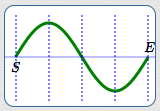
Basic sine cycle
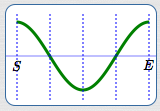
Basic cosine cycle
As discussed in the next section, amplitude is the distance from the $x$-axis to the highest (or lowest) part of the graph.
The amplitude of $\,y = \sin x\,$ and $\,y = \cos x\,$ is $\,1\,.$ Vertical scaling by a factor of $\,a\,$ causes the amplitude to change to $\,|a|\,.$
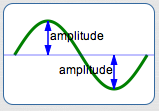
Vertical scaling by a factor of $\,-1\,$ causes reflection about the $x$-axis (i.e., a ‘flip’).
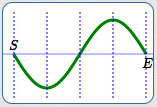
Basic sine cycle, flipped
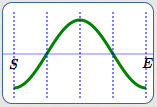
Basic cosine cycle, flipped
Draw in the basic cosine cycle, flipped.
The amplitude is $\,7\,.$
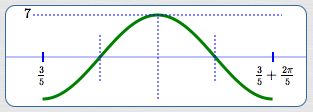
To emphasize:
In this graph of (one cycle of) $\,y = -7\cos (5x-3)\,$:
- The fact that it is a cosine curve, $\,y = -7\color{red}{\cos}(5x-3)\,,$ causes you to use the basic cosine cycle.
- The leading minus sign, $\,{\bf\color{red}{-}}7\,,$ causes the cycle to be flipped.
- The amplitude is $\,|-7|\, = 7\,.$
